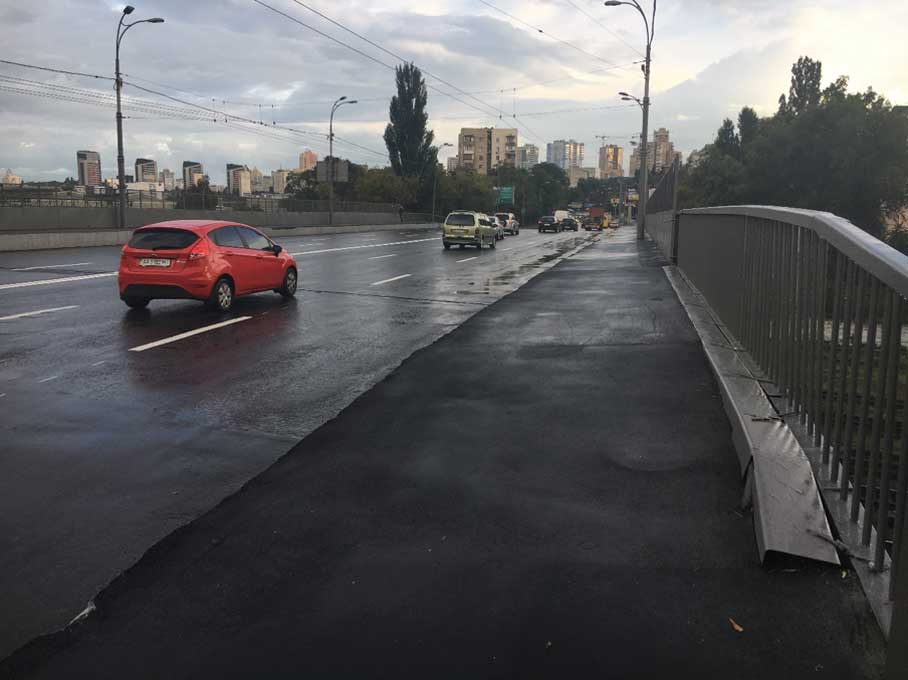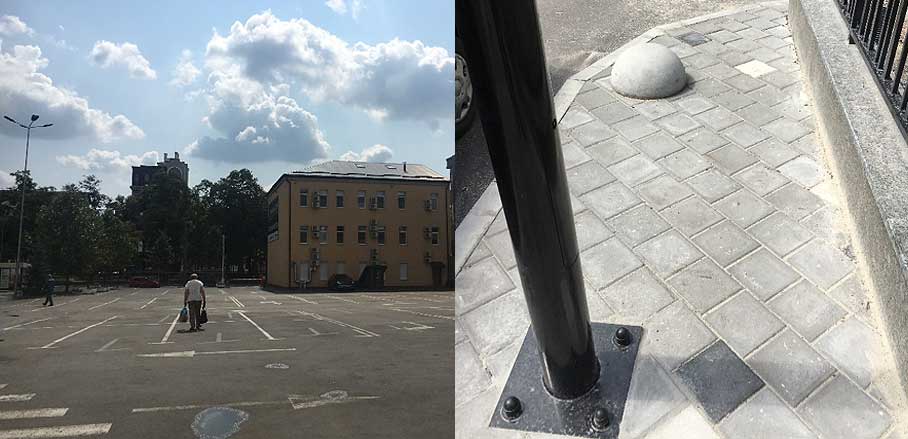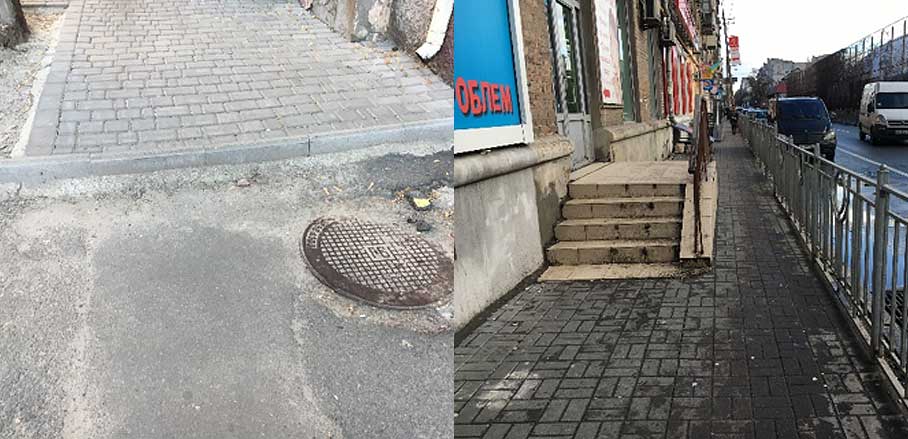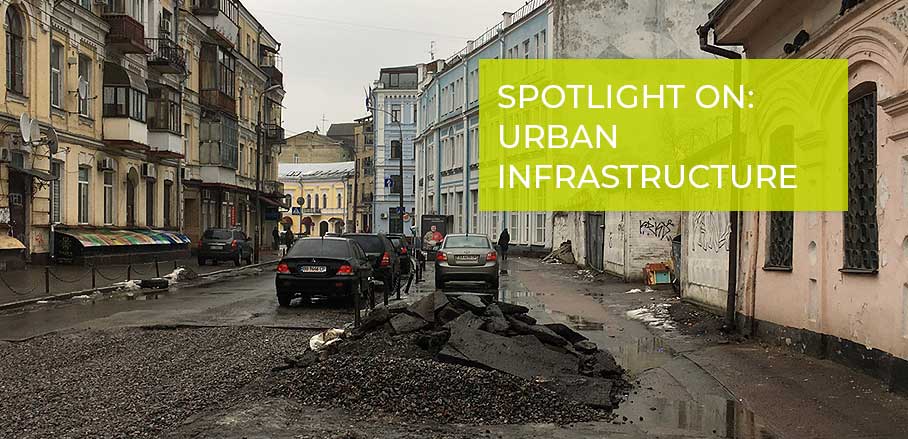The (Un)walkable City: The Pedestrian Crisis in Kyiv
Street design in Kyiv, Ukraine leaves something to be desired: walkability. Oleksandr Anisimov analyses how it needs to change so that everyone can use public space.
Upon returning from a trip to the EU back to Ukraine, you notice a dramatic change. You start feeling the city immediately. Waiting times for public transportation are extremely, you have to jump over puddles and watch your step to avoid potholes—all in all, it takes a lot of effort just to move around in the city.
Imagine you are a parent with a baby in Kyiv and you need to leave your flat on Tuesday morning. What do you do? You always call a taxi beforehand, if you can afford it. This is because you can never rely on the street. There is a high probability that you will be met with bumps, holes, puddles after the rain, snow hills and ice in winter and mud in spring. The further from the centre you go, sidewalks are less and less maintained. The fact that the city is very hilly only adds risk to your pedestrian journey.
An Unwalkable City
I would call this a crisis of pedestrian practices, as walking disappears as an option to get from A to B or to simply move around in public space. As we all know from urban designer Jen Gehl’s observations, voluntary activities happen on the street only if the necessary infrastructure is in place. Without benches, relative silence, and clean air it is much less likely that people will stroll along the street or meet up with friends.
Working as an urban researcher at the NGO “Agenty zmin” for the last two years, I inspected more than 100 streets in Kyiv. Together with my team, I noted down pavement quality shade provided by trees, street lighting, pedestrian crossings and much more. We found out a few reasons why the city is inaccessible for people with disabilities and hard to navigate on foot for others. It is that city streets, being a key part of urban infrastructure, are badly managed in three main ways:
- Standards and priorities of street reconstruction and repair mainly focus on their role as roads for motorized vehicles. This leads to an overinvestment in asphalt and a shiny look of the road that appeals to car drivers. The main roads that drivers use are much better maintained than others; pedestrian users are not considered at all. Street lighting also favours cars: cold and powerful light is cast on the road, while sidewalks often remain unlit.
- Citizens do not have a say in street design, as it is considered a domain of professional planners and engineers. Since they are experts and will listen only to their peers, the voices of regular citizens are ignored. Nobody assesses the street experience of city dwellers. On the contrary—the general attitude is that pedestrians should be glad that sidewalks exist, and not complain about their quality.
- The responsibility of street management is divided between several communal enterprises managed by the city, none of which cares about the street as a whole. Lights, bus stops, underground pipes, and pavement are all taken care of separately so that a comprehensive approach is almost impossible. Architects are never involved in street redesign as a result, as there is no entity that has the right to guide the whole process.
At the same time, the city points to a shortage of funds when asked about street quality. But we need to be aware that money itself does not guarantee quality at any level. The problem is often not a lack of finances, but related to the mindset, rules and practices that guide urban redesign. A few recent examples from Kyiv show that money matters very little.
Examples of Faulty Urban Design
This photo shows a bridge that was repaired, with a newly constructed sidewalk. It is completely unsafe, is tilted at an angle onto the road and is too narrow for two people to move alongside each other simultaneously.

© Oleksandr Anisimov
Here, for instance, a business centre spent a lot of money on pricy materials and design for the construction of a new parking lot, but neither they nor the city thought of providing shelter from the sun and creating clear and safe passageways for pedestrians. As a pedestrian, you are not able to pass comfortably, though pricy materials and fancy design are in place.

© Oleksandr Anisimov
In the two cases below, repairs made the street even worse. You can neither expect non-slippery pavement in winter nor an even and wide enough space to pass through. Though all these projects went through a planning process with experts that involved some kind of quality control, the outcome squashes any desire to use the street.

© Oleksandr Anisimov
Even though Kyiv is still a long way from being a pedestrian-oriented city, there are a lot of people who walk down the streets every day out of necessity and due to a lack of alternatives. Hence, they become more and more convinced that they need a car to feel safe and comfortable in the city. We as urban professionals know that this leads nowhere. But how can we promote a sustainable city when the basic needs of human movement are not met? The quality of sidewalks is not only a question of the right of equal access to city services, but of the future of the city itself.
What Can Be Done?
We need to amend the existing procedures and set new clear priorities for urban management.
New procedures of street redesign and repair should give up the idea of all-knowing expertise of engineers and put in place an equal, dialogue-based discussion with citizens. City department officials need to find a way to involve different stakeholders in the planning process. They should nevertheless be conscious of drivers’ desire to have free parking space and never let this override the needs of disadvantaged citizens. We also have to take into account the needs of people without a voice in these debates: children and elderly people.
New priorities should be set and widely accepted within city management. These new priorities should include:
- Street redesign and maintenance has to be based on human happiness and comfort, with the needs of those for whom it is not easy to use the city (elderly, people with disabilities, children) at the centre of all considerations. The amount of square meters of asphalt should not guide the terms of reference for street design any longer.
- Nature preservation has higher priority than basic street quality criteria. Green zones are a refuge from fumes and dust and reduce the impact of heat island effects in summer.
- Street space needs to be considered as the most valuable asset the city has. It should not be wasted on car parking or asphalt lanes. It can make the city more liveable, generate vitality, and improve the overall quality of life.
A good starting point would be to set up an independent educational and advisory office for the city administration that can gather expertise, best practices, and critically reflect on the agenda concerning the redesign of public space.
- The (Un)walkable City: The Pedestrian Crisis in Kyiv - 5. March 2019
